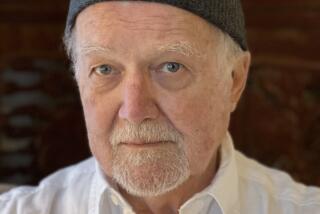‘Who Is Mark Twain?’
When he died 99 years ago this week, Mark Twain was this country’s most beloved writer, yet his status as both an author and protean example of the now-familiar pop cultural celebrity seems to grow with each passing decade.
“Who Is Mark Twain?” -- a collection of 24 previously uncollected stories and essays drawn mostly from the vast archive of the author’s papers and correspondence at UC Berkeley’s Bancroft Library -- is an entertaining reminder of why that’s so.
Twain’s death of heart disease at the age of 74 came as such a blow to the country that it evoked an expression of official White House regret from President William Howard Taft: “Mark Twain gave pleasure -- real intellectual enjoyment -- to millions, and his works will continue to give such pleasure to millions yet to come. . . . His humor was American, but he was nearly as much appreciated by Englishmen and people of other countries as by his own countrymen. He has made an enduring part of American literature.”
Popular and critical opinion rarely coincide so closely -- and even less frequently is that critical opinion shaped by other working writers.
Ernest Hemingway famously argued that “all modern American literature comes from one book by Mark Twain called ‘Huckleberry Finn,’ ” though even he conceded that the great novel’s disastrous final section is “just cheating.” (To this critic’s mind, a canonical case also can be made for Melville’s “Bartleby, the Scrivener” and “The Confidence-Man.” Still, what other 19th century American novel so controversial in its own time -- though for different reasons -- remains so today?)
William Faulkner, to whom praise of other novelists did not come easily, called Twain the “first truly American writer” and said he “wrote the first American sentences.”
The poet Kenneth Rexroth, whose shrewd critical appraisals are too often overlooked (see “The Classics Revisited”), wrote that, “If Baudelaire was the greatest poet of the capitalist epoch . . . Mark Twain wrote its saga, its prose Iliad and Odyssey” in “The Adventures of Tom Sawyer” and “The Adventures of Huckleberry Finn.” Rexroth goes on to add that Twain wrote that saga “because he knew how to survive to write it.”
For Twain’s fans, these 24 short -- six, in fact, incomplete -- pieces are a wonderful example of that survival mechanism in operation and how it’s one of the things that gives the author’s relationship with both his audience and posterity the contours of what we recognize as celebrity. (They also bring into high relief the fact that Twain’s progeny these days can be watched nightly on Comedy Central’s Jon Stewart and Stephen Colbert shows.) Although Twain was unafraid of exposing -- to those who came after him, at least -- his process of “becoming” an artist, he also had a keen sense of just what his readers would and would not accept.
As Robert Hirst -- general editor of Berkeley’s Mark Twain Project and the selector of these pieces -- points out in his excellent and accessible introduction, Samuel Clemens liked to try things out before publishing under his pen name. One of the stories in this volume is “The Undertaker’s Tale,” whose conceit was, in Hirst’s words, “to throw a typical Horatio Alger hero into a family of undertakers” and let things take their course.
As was his habit, Twain read the completed tale to his wife and children on the evening he finished it. As one biographer describes the result: “No one spoke during the reading, nobody laughed. The air was thick with disapproval. His voice lagged and faltered toward the end. When he finished, there was heavy silence. Mrs. Clemens was the only one who could speak, ‘Youth, let’s walk a little.’ ” Shortly afterward, Twain tried the story on his friend, the utopian socialist William Dean Howells . . . then put it away forever.
Twain, as Hirst points out, was willing to put aside -- but not destroy -- works he deemed unsuitable for publication, and he did that not merely for aesthetic reasons but also because he believed his readers would not accept his sharper opinions, particularly when they touched on organized religion or theism. Twain, though an unbeliever, was one of the first American cultural observers to intuit that the country’s great problem was not religion per se but a surfeit of religiosity. He also was aware that few of his readers were prepared to accept his advanced political views, which were all the more remarkable in that he’d been born in the divided border state of Missouri, served a couple of desultory weeks as a Confederate irregular, then became one of the few Americans to sit out the Civil War as a neutral in Nevada.
Once he moved to Connecticut and married, his wife, Olivia, introduced him to a dazzling set of radical American thinkers, including Howells and Frederick Douglass. Twain became a passionate defender of racial equality, an early champion of women’s suffrage, a fervent anti-imperialist -- even during the Spanish-American War -- and, as is less known, an advocate for organized labor, who once told a gathering of the radical Knights of Labor:
“Who are the oppressors? The few: the King, the capitalist, and a handful of other overseers and superintendents. Who are the oppressed? The many: the nations of the earth; the valuable personages; the workers; they that make the bread that the soft-handed and idle eat.”
As the continuing flow of unpublished material from the voluminous papers he left shows, Twain had a good sense that his relationship with the audience on whose regard his monetary well-being depended might not survive to frank airing of such views. He had a keen sense, in other words, for the line between the good-humored provocation and the in-your-face affront, something that presages (unheeded) our own notions of celebrity conduct.
Most of all, though, “Who Is Mark Twain?” is worth reading for the sheer pleasure of rediscovering why this writer was so popular in his day. Even when wrong-headed, Twain is engaging. He loathed Jane Austen, for example, as he did George Eliot and Robert Louis Stevenson. “Whenever I take up ‘Pride and Prejudice’ or ‘Sense and Sensibility,’ ” he writes, “I feel like a barkeeper entering the Kingdom of Heaven. I mean I feel as he would probably feel, would almost certainly feel. I am quite sure I know what his sensations would be -- and his private comments. He would curl his lip, as those ultra-good Presbyterians went filing self-complacently along. Because he considered himself better than they? Not at all. They would not be to his taste -- that is all.” Austen, Twain muses, seems to spend the first half of every book getting you to “detest” her characters and the second half convincing you to like them.
There speaks the timeless iconoclast.
More to Read
The biggest entertainment stories
Get our big stories about Hollywood, film, television, music, arts, culture and more right in your inbox as soon as they publish.
You may occasionally receive promotional content from the Los Angeles Times.










